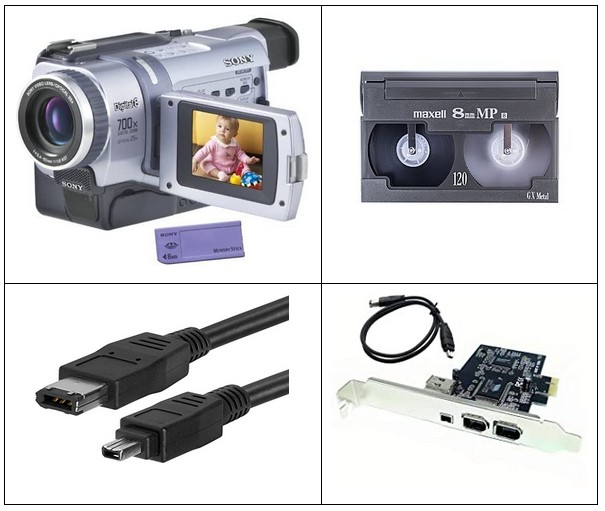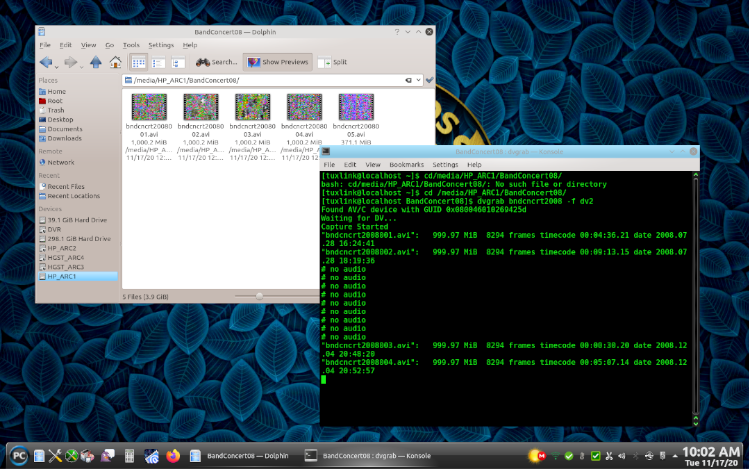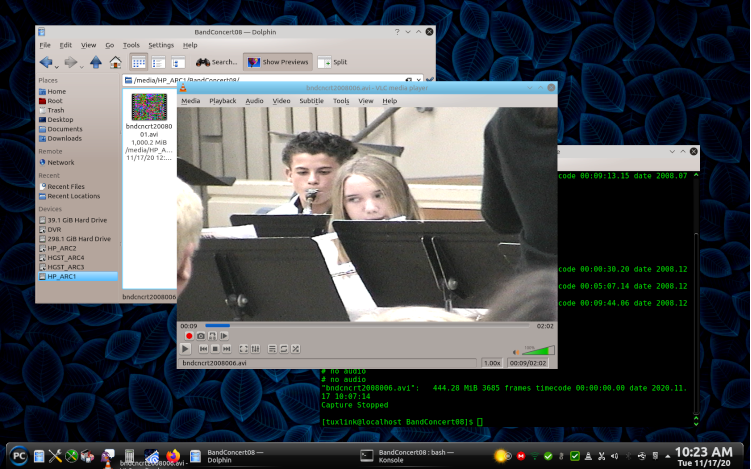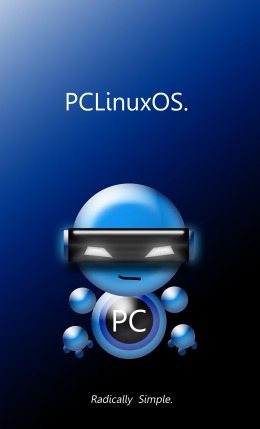| Previous
Page |
PCLinuxOS
Magazine |
PCLinuxOS |
Article List |
Disclaimer |
Next Page |
Analog Video Archive Project |
|
by tuxlink Today, modern DSLR cameras shoot video content as easily as they shoot stills. Video data can be loaded directly into an editor like Kdenlive, or Openshot for final preparation of rendering and viewing. However, not so long ago, shooting video meant also using the available media of the day. Back then, that meant plastic magnetic analog tape. At first for consumers, it came in large VHS cassettes, and then later in smaller forms VHS-C and then 8mm. By the time 8mm was popular, here came Digital Video over the horizon. Most people shoot and record memories on still cameras and video cameras. This process has a habit of getting out of control very quickly. In a few short years, folks are left with more than a few issues about how to easily display and save their precious memories for future generations to enjoy. Let's first look at the display options. In the past, pictures and photos were either framed and hung up, or they languished in a shoebox until future generations showed an interest in them. Depending on how much effort they want to put into the project, they save some in an album, and either toss the remainder or return them to the shoebox for more time travelling. Today, with computers, there's many more ways to display and use still images. With video memories, we have the option to connect the camera to the TV for viewing, or maybe saving the data to a networked drive for later streaming, or up to social media. In my own personal case, I needed to first transfer all of the analog 8mm video tape over to digital and save the data to hard drives for future editing or viewing. I wanted to do this after reading warnings about plastic magnetic tape media slowly decaying over time and in some cases becoming unreadable by the devices that were used to record them. My second fear was the video camera itself becoming old and failing because of age. So the clock was indeed ticking and a course of action was needed to save the precious memories of yesterday. There are many commercial services available that will take your set of recorded memories and transfer them from analog to digital for a price. After seeing a case on the news about an individual who tried one of these copying services, only to discover the company doing the work had lost the original set of photographs and video tapes, I decided that idea was never worth the risk, no matter what they charged nor how quickly they completed the job. Can you imagine losing years of personal family memories?  For this reason, I decided to take on the project of transferring the analog data from a number of Hi 8mm video tapes that we had accumulated over the past few years. I had been warned that a project like this would entail devoting a lot of time to it. Each tape has about 90 minutes of recording time on it, and while there is not always a full tape of data, you still must sit through each tape and make sure there are no errors in the process. The last thing I wanted to have happen is the whole process being ground to a halt by either a software or hardware error while I was not watching. So, because of our wonderful Global Pandemic, I suddenly found myself with not only the time to carry out this work, I also had everything I needed to successfully transfer all the data from the tapes to my desktop computer hard drive. I planned to use the camera I shot the scenes with, to now operate as a VCR while connected to my computer via a Firewire IEEE 1394 cable. I had purchased a PCI Firewire adapter card to fit into my computer. The capture cards run between $15-$60. You can easily find them on Amazon or in most Electronics stores. The Firewire cable cost about $9.99. Make sure you get the right one to fit both your capture card and camera. My video camera is a Sony Handycam and it's dated around the early to mid 2000's. Back then the method of transfer that was popular was Firewire. Today, you can simply use a USB cord to connect most video cameras to computers, or even remove the SD card and have it read in a card reader, either built in, or attached via cable. So there I was, believing I was ready to get started capturing memories from the tapes. After doing some research about what software to use, and trying some testing to determine which was best to depend on, I opted for a Linux command line program by the name dvgrab. It's a small application that does what it was designed to do, very well. Dvgrab is in the PCLinuxOS repo and has a powerful set of options to use with the basic command. Even though dvgrab is now a dead project, the website is still accessible here. It was the program I started this project with back in the mid 2000's, and I decided to continue using it because it did what I wanted very well. You can read all about what each option does by invoking dvgrab --h. Dvgrab was basically designed to capture linear video in either one large file or several smaller sized files. A new file can be created where the stops and starts of the content is located, or a predetermined file size can be set and when that file size is reached, it automatically starts a new file. As in most Linux applications, there are a lot of features that not every user will use or even need. After some of my initial testing, I discovered it didn't like my asking it to save a whole video tape as one large file, it dropped frames and showed a number of errors, eventually bringing the capture process to a complete halt. I changed the command to save files in chunks sized 999mb's. This it liked a lot better and the process merrily cranked out video files sequentially numbered for easy use in a video editor later. Let me mention another issue that needed some thought. Transferring analog video to digital data takes up a lot of hard drive real estate. According to Google, you can fit about 1.6-3.6 minutes of video into 1 GB of hard drive space depending on the resolution. So that made it clear to me that my old 350GB hard drive that was only half full, was not going to be half full for very long! Thinking long term, I decided to purchase two new large hard drives. My children are in their twenties now, and I figured in time they'd each need a copy of this archive project for future use within their own families. My goal was to save all the edited video and photos onto a new hard drive that I could hand over to both of my children, so a double copy needed to be made when all was said and done. After a few searches online, I pulled the trigger on two 2TB hard drives costing about $40 each. I installed them, and was cranking out digital video files in no time.  Keeping an eye on the transfer process as files fill the named/dated folder. I figured there was going to be a lot of files to deal with, so keeping track of everything became very important. I needed a strategy that would allow me to name and date the files. So, I decided to view the first few minutes on each tape and create both filenames and folders based on it, i.e. /Ninja2009/ was the folder, (I used to ride a Kawasaki Ninja 900!). Each file inside was named ninja200901.avi, ninja200902.avi, and so on. This worked well, as each tape yielded a different number of files. The names and dates help with editing and searching in the future. After changing to the empty new folder at the prompt, the command that set it all in motion boiled down to, dvgrab filename -f dv2. I was able to view the content as it rolled by on the pullout screen of the Handycam, and monitor the progress of the transfer on my monitor. Dvgrab by itself automatically creates a file size of 999mb's. I added the -f dv2 option to create an extra soundtrack copy as I like to add musical soundtracks to my videos, as well as the recorded soundtrack. Finally, when the files were finished transferring, I viewed random files in VLC to make sure they played properly.  Testing video files in VLC after the transferring is complete. It takes about two hours to transfer a full tape, but I set myself a small goal to get up each morning and set the whole process in motion. That was back in early September 2020, and by November 2020 I was already on the final tape, thirty in all! If you have a lot of video that needs transferring to digital and archiving, I would start sooner rather than later. Time is against you in more ways than one. It was a fun, enjoyable project and one more item I can cross off my list of Honey-Do's. Thank you to those who answered my questions in the forum about various items related to this project. |


